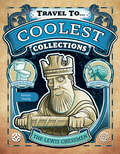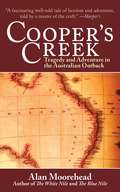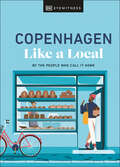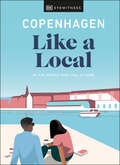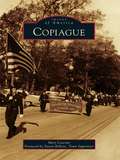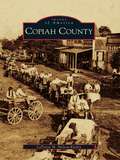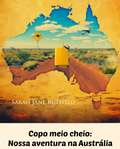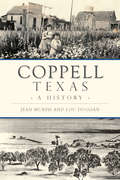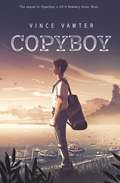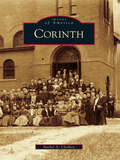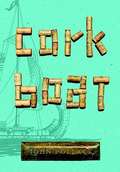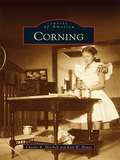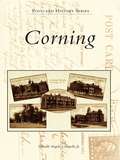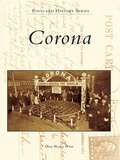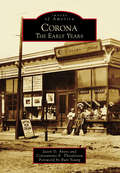- Table View
- List View
Coolest Collections (Travel to...)
by Kaitlyn DulingIntroduce your child to different aspects of history and the roles museums play in the community in the children’s book Coolest Collections.What are some of the quirkiest museum collections in the world? Learn about the impact museums have on preserving history and priceless artifacts.Storybook Features:This children’s book features an index, a glossary, bolded text, and new vocabulary to help develop reading skills.48 pages with vivid photographsLexile 1080LAbout RourkeWe proudly publish respectful and relevant non-fiction and fiction titles that represent our diverse readers, and are designed to support reading on a level that has no limits!
Coolidge
by Ralph A. SwainEven by Arizona standards, Coolidge is a relatively "new" town. Its original site was platted in 1925 with a modest 80 acres purchased by Phoenix businessman Richard J. Jones, and it would be another 20 years before the town was incorporated. Nevertheless, the Coolidge environs possess a rich and colorful history going back several thousand years when the ancestral Sonoran people began building permanent structures and constructing canals to divert Gila River water for their crops. Two hundred years after the ancient civilization abandoned the area, Spanish explorers passed through on their way to California. But it was ultimately the establishment of main line rail service, the construction of a dam, and the building of the only north-south highway between Tucson and Phoenix that led to the formation of this town named after America's 30th president.
Coolies
by Yin Chris SoentpietWhen Shek and little Wong journey to America in 1865, they have work! Along with hundreds of other Chinese, the brothers are going to help build a great railroad across the West. But as days grow into months, Shek and Wong endure more than they could have imagined--bleeding hands, blasting dynamite, and treacherous avalanches. For very little pay. Are they being treated this way because of their almond-shaped eyes--because they are coolies? Inspired by actual events in the history of the American railroad, Cooliesa reveals the harsh truth about life for thousands of Chinese laborers, while it celebrates the love and loyalty between two brothers who were determined not only to survive, but to succeed.
Cooper's Creek: Tragedy and Adventure in the Australian Outback
by Alan MooreheadIn 1860, an expedition set out from Melbourne, Australia, into the interior of the country, with the mission to find a route to the northern coast. Headed by Robert O'Hara Burke and William John Wills, the party of adventurers, scientists, and camels set out into the outback hoping to find enough water and to keep adequate food stores for their trek into the bush. Almost one year later, Burke, Wills, and two others from their party, Gray and King, reached the northern shore but on their journey back, they were stranded at Cooper's Creek where all but King perished. Cooper's Creek is a gripping, intense historical narrative about the harshness of the Australian outback and the people who were brave enough to go into the very depths of that uncharted country.
Coopers Rock Bouldering Guide (Bouldering Series)
by Tim Keenan Dan BrayackCooper's Rock Bouldering Guide features more than 400 bouldering problems at Cooper's Rock State Forest, a popular rock climbing area in north-central West Virginia. The authors provide in-depth information and precise detail about finding and ascending the best lines and classics, and take the guesswork out of locating some of the top problems amid the vast boulder fields. With this comprehensive guide in hand, discover the best seasons to go, what to bring, and where to camp, find food, and purchase gear.
Copenhagen Like a Local: By the People Who Call It Home (Local Travel Guide)
by DK Eyewitness Monica Steffensen Allan Mutuku KortbaekThis isn't your ordinary travel guide. Beyond Copenhagen's Michelin-starred restaurants are moody jazz bars, eco-conscious shops, and scenic swimming spots that locals love - and that's where this book takes you. Turn the pages to discover: The small businesses and community strongholds that add character to this vibrant city, recommended by true locals6 themed walking tours dedicated to specific experiences, such as alternative shopping and brewing historyA beautiful gift book for anyone seeking to explore CopenhagenHelpful what3word addresses so that you can pinpoint all the listed sightsA thoughtfully updated second edition, including new places to visit Compiled by two proud Copenhageners, this stylish travel guide is packed with Copenhagen's best experiences and secret spots, handily categorized to suit your mood and needs.Whether you're a restless Copenhagener on the hunt for a new hangout or a visitor keen to discover a side you won't find in traditional guidebooks, Copenhagen Like A Local will give you all the inspiration you need.Looking for another guide to Copenhagen? Explore further with our DK Eyewitness or Top 10 guides to the city.
Copenhagen Like a Local: By the people who call it home (Local Travel Guide)
by DK Eyewitness Monica Steffensen Allan Mutuku KortbaekExplore the hidden gems that Copenhagen has to offer, from the people who call it home to your pocket with this insider&’s travel guide.Whether you're a local looking to traverse the wonder of your city or a travel bug-bit nomad seeking truly authentic experiences, this stylish guide is the ultimate travel counsel, leading you beyond the typical tourist track on a memorable adventure.Beyond the well-trodden sights, there&’s a secret side of the city. This travel guide to Copenhagen includes: • Two-color, bold modern design with contemporary illustrations throughout • Authors are true locals and have been picked for having their fingers on the pulse and their diverse tastes. Their suggestions and advice sit alongside quotes from Copenhagen creatives, volunteers and business leaders to give the book a local feel • Narrative style throughout, making the local, personal voice central to every entry • Structured by six themes: Eat, Drink, Shop, Art and Culture, Nightlife and Outdoors • Each entry includes its unique address so readers can pinpoint precisely where they are heading • Each theme ends with a tour spread, dedicated to a specific interest or experience. For example, a foodie tour of the meatpacking district This travel book is packed with surprise tips and recommendations for exploring the endlessly enticing city. You won&’t want to wait long to travel to Copenhagen! Covering firm favorite hangout spots and hidden happenings ranging from pure extravagance to budget-friendly, make it a perfect travel gift for the nomads in your circle.Enjoy New Nordic cuisine at one of the world's best restaurants, take a dip in the inner city harbor or check out the street art in Freetown Christiania. The best part? Included are tips on how to travel sensibly in a post-Covid world without compromising on experience. Don&’t wait to discover secret places that only a local would know, hands-on experiences, and ideas for traveling solo, in a pair or with a crowd.From New York and London to Paris and Tokyo, there are more places to discover with these niche local guides! Written by the people who call it home, the Like A Local series from DK takes you beyond the tourist track to experience the heart and soul of each city!
Copiague
by Mary Cascone Steven BelloneAlong the shores of Long Island's Great South Bay, the Copiague area was a haven for Native Americans and, later, colonial settlers. Previously known as Huntington South, East Amityville, Great Neck, and Powell's, the hamlet adopted the name Copiague in the 1890s. Pres. George Washington's celebrated 1790 sojourn is one of the high points in Copiague history, as are the visits of famed wireless inventor Guglielmo Marconi in the early 1900s, when he came to review his namesake Marconiville community. In the 1920s, rural Copiague grew to include the beach communities of American Venice, Amity Harbor, and Hawkins Estates and set the stage for the monumental suburban expansion of the 1950s. Beginning in the early 20th century, Copiague also became the adopted home to immigrants from all around the world. Copiague has a rich tradition of community service institutions--its fire department, public schools, veterans' organizations, and churches, including Bethel A.M.E. Church, celebrated as the oldest black church on Long Island.
Copiah County (Images of America)
by LaTricia M. Nelson-EasleyNamed after a Native American word meaning "calling panther," Copiah County was organized after an agreement was reached with the Choctaw Indians in the Treaty of Doak's Stand in 1820. Located 20 miles from the state capital of Jackson, the county was organized in January 1823 and quickly became an agricultural and manufacturing namesake. Once known as the "Tomato Capital of the World," the county was the location of the largest Chautauqua assemblies in the South and the site of the founding of the Mississippi Parent Teacher Association. The extinct town of Brown's Wells once produced spring water that "healed" the rich and famous. Notable citizens from Copiah County include bluesman Robert Johnson; Maj. R. W. Millsaps, for whom Millsaps College was named; Burnita Shelton Matthews, the first female federal district court judge; Pat Harrison, a former representative and senator; Albert Gallatin Brown, a former governor; and Fannye Cook, an author and the first director of the Mississippi Museum of Natural Science.
Copo meio cheio: Nossa aventura na Austrália
by Sarah Jane Butfield Márcia de Medeiros SouzaCopo meio cheio: Nossa aventura na Austrália é a história de uma família britânica que toma uma das decisões mais difíceis de sua vida, emigrar para o interior da Austrália para viver o seu sonho. Por que essa decisão era tão difícel? Bom, a família é formada por vários núcleos, o que significava que alguns dos filhos iriam ficar no Reino Unido com os ex-parceiros. Após ter resistido a um complicado divórcio e inúmeras batalhas judiciais pela custódia dos filhos, Sarah Jane sabia que esta era a única chance deles de felicidade e que, como uma família, estavam tomando a escolha certa. Eles trabalharam duro e planejaram para que tudo desce certo e foi o que ocorreu, até que eventos que mudaram a vida deles começaram a testar as fundações dessa resistente famíia. Apenas quando eles pensavam que o pior já havia passado, a Mãe Natureza interveio e levou embora as raízes de sua nova vida durante as inundações de Brisbane em 2011. Este livro conta como essa mulher surpreendente e sua corajosa família lutaram para manter vivo o seu sonho e usaram toda a positividade disponível para ter novas esperanças e novos recomeços. A vida não existe sem seus desafios. Quantos eventos transformadores uma família pode suportar antes que tudo vá pelos ares? Descubra nesta inspiradora e tocante história real.
Coppell, Texas: A History (Brief History)
by Jean Murph Lou DugganCoppell history is rooted in peace and community. In 1843, Sam Houston met with ten native tribes along Grapevine Springs Creek to negotiate an accord to end fighting and allow trade and settlement in the area. When Dallas/Fort Worth International Airport opened in 1974, Coppell transformed from a farming hamlet into a thriving town with expanding economic opportunity. Through firsthand accounts with longtime residents and meticulous research, authors Jean Murph and Lou Duggan unfold the contemplative story of a complex and historic community.
Copyboy
by Vince Vawter Alessia TrunfioThe sequel to the Newbery Honor-winning novel Paperboy and a Fall 2018 Junior Library Guild selection Victor Vollmer isn't a paperboy anymore. He's a copyboy now, but his duties at the newspaper get interrupted by a last request from Mr. Spiro, the old man who became Victor's mentor and helped him take on his stutter in the beloved novel Paperboy, a Newbery Honor Book. Victor takes off on a journey that sends him hundreds of miles from home--toward the teeth of a gathering storm. Confronted by an unfamiliar and threatening world, he meets a girl who is strong, smart, and bold like no one he's known before, and together they venture to the place where river meets sea. When they wind up racing to evade a hurricane, Victor finds out what the fates have in store for him.
Corals of Florida and the Caribbean
by George F. WarnerPresenting a stunning array of beauty and biodiversity, the coral reefs of Florida and the Caribbean are part playground, part research lab for the thousands of tourists, divers, and marine scientists who visit them every year. Documenting the wide array of corals at home in the warm waters of the Caribbean, George Warner's Corals of Florida and the Caribbean provides an easy-to-use (and carry) guidebook that is both scientifically accurate and reader friendly.Warner provides an exhaustive identification guide that will enrich any novice's vacation dive or an expert's return to the reefs. Written for the amateur naturalist, this handbook will travel well throughout the Caribbean, from Florida south to Belize, east to Tobago, and all points in between.Beyond documenting the wide variety of corals found in the Caribbean, Warner also outlines their biology, from the way they grow to their reproductive habits, while examining major threats to the reefs including hurricanes, pollution, and global warming. With over 150 color photos, most taken by the author himself, as well as detailed descriptions, Corals of Florida and the Caribbean makes identifying and learning about corals hassle free--on the boat, at home, or in the classroom.
Coralville
by Timothy WalchAlthough Coralville is a lot like other small American cities, it is unique as the only community of that name in the United States. Located on the Iowa River, the name refers to the ancient coral reefs that are its geological bedrock. The river has always been a key aspect of Coralville's history, along with its proximity to Iowa City, the first capital of the Territory of Iowa and the home of the University of Iowa. Incorporated as a city in 1873, Coralville had few residents until the 1960s, when dynamic commercial and residential development brought substantial growth to the area. Today, Coralville is a city of industry, commerce, and hospitality. It is not surprising, therefore, that "Coralville Pride" is the city motto.
Corinth (Images of America)
by Rachel A. ClothierCorinth's name, selected from the Bible, was chosen when the township was first incorporated in 1818. Situated perfectly to benefit from the surrounding natural resources, Corinth has a long history as a mill town, processing timber, wool, and grains using the power of the Hudson River. Located at the northern edge of Saratoga County, Corinth has been both a rural agricultural community and an industrial center. It is home to several churches, community organizations, and businesses, as well as one of International Paper's largest mills, which used the Hudson for both transportation and energy generation. Within Corinth, readers will discover the area's past through images of mill workers, schoolchildren, farmers, shopkeepers, and other residents, as well as the homes and businesses they built.
Cork Boat
by John Pollack165,321 corks1 boatMost people have childhood dreams; few ever pursue them. At the age of 34, John Pollack quit a prestigious speechwriting job on Capitol Hill to pursue an idea he had harbored since the age of six: to build a boat out of wine corks and take it on an epic journey.In Cork Boat, Pollack tells the charming and uplifting story of this unlikely adventure. Overcoming one obstacle after another, he convinces skeptical bartenders to save corks, corrals a brilliant but disorganized partner, and cajoles more than a hundred volunteers to help build the boat, many until their fingers bleed. Hired as a speechwriter for President Clinton midway through construction, Pollack soon has the White House saving corks, too. Ultimately, he and his crew set sail down the Douro River in Portugal, where the boat becomes a national sensation. Written with unusual grace and disarming humor, Cork Boat is a buoyant tale of camaraderie, determination, and the power of imagination.
Corning
by Kirk W. House Charles R. MitchellLenses for railroad lanterns, cut glass for the White House table, Thomas Edison's first light bulb-the glass for all of these was made in Corning, the glass capital of America, the Crystal City. From 1880 to World War I, newfound wealth sparked a spending and building boom that shaped the city. Corning recaptures the city's gilded age, the boom days when tax-free fortunes could be made-and lost-overnight. Vintage photographs show elephants and buffalo parading down Market Street, the Drake family giving recitals on its home pipe organ, churches and public buildings rising, carriages giving way to motorcars, and huge summer homes springing up on the Finger Lakes.
Corning
by Donald Angelo Carapella Jr.In the 1830s, when a feeder branch of the Erie Canal linked up with the Cheumung River, Corning first became connected to the rest of the world. By the 1880s, Corning had become a railroad town with trains going in all directions. Industrial growth in the 1890s led to the rise of businesses and factories, such as Corning Glass Works. Because Corning produced so much glass, it became known as the crystal city and grew into a tourist destination. A town with many accomplishments, Corning was once home to a minor-league baseball team and is the birthplace of Margaret Sanger, a birth control activist who founded the American Birth Control League, which became Planned Parenthood. From the 1890s until the 1960s, the growth of the community's businesses, parks, churches, and recreation were captured in postcards, many never published before.
Corona
by Mary Bryner WinnSeveral times in the late 20th century, Corona was cited as the fastest-growing city in California, doubling and tripling its former sleepy-town size of around 25,000 in the 1970s to 150,000 in a matter of just decades. Corona has come a long way from its former offshoot identity as South Riverside in the late 19th century. Incorporated as Corona in 1896, itsurvived as a dry-farming community until the arrival of citrus crops. Its status as a way station for travelers between Los Angeles and the outlying desert communities was dramatically altered in the mid-1910s when it became an internationally recognized road-racing draw for the likes of Barney Oldfield and other great speedsters of the day. As abedroom community today for workers in Orange and Los Angeles Counties, it is virtually a prototype of Southern California suburban growth.
Corona: The Early Years (Images of America)
by Jason D. Antos Burt Young Constantine E. TheodosiouNestled between old Newtown (today's Elmhurst) and the village of Flushing in the borough of Queens lies Corona. Blessed with an enchanting landscape, the area attracted development as early as 1854, when the West Flushing Land Company sought to create a suburban residential neighborhood in its midst. For Corona's cherished way of life, represented by Colonial-era farms, dirt roads, and gaslight streetlamps, this marked a distinct break from the past. Developer Benjamin Hitchcock's novel installment-plan system had helped place Corona on the map for good by 1870, laying down a historical precedent for later communities like Forest Hills and Jackson Heights to take shape. Before Mets baseball and the US Open were fixtures on the local scene, New Yorkers flocked to the National Race Course, one of the first such complexes in the entire country, for an exciting day at the races. Meanwhile, in its Corona-based factory, the Tiffany Glass Company forged distinctive lamps and glassware that in time would become world famous.
Coronado's Children: Tales of Lost Mines and Buried Treasures of the Southwest (Barker Texas History Center Series)
by J. Frank Dobie&“This is the best work ever written on hidden treasure, and one of the most fascinating books on any subject to come out of Texas.&” —Basic Texas Books Written in 1930, Coronado&’s Children was one of J. Frank Dobie&’s first books, and the one that helped gain him national prominence as a folklorist. In it, he recounts the tales and legends of those hardy souls who searched for buried treasure in the Southwest following in the footsteps of that earlier gold seeker, the Spaniard Coronado. &“These people,&” Dobie writes in his introduction, &“no matter what language they speak, are truly Coronado&’s inheritors . . . I have called them Coronado&’s children. They follow Spanish trails, buffalo trails, cow trails, they dig where there are no trails; but oftener than they dig or prospect they just sit and tell stories of lost mines, of buried bullion by the jack load . . .&” This is the tale-spinning Dobie at his best, dealing with subjects as irresistible as ghost stories and haunted houses. &“As entrancing a volume as one is likely to pick up in a month of Sundays.&” —The New York Times &“Dobie has discovered for us a native Arabian Night.&” —Chicago Evening Post
Coronado's Children: Tales of Lost Mines and Buried Treasures of the Southwest (Barker Texas History Center Series)
by J. Frank DobieWritten in 1930, Coronado's Children was one of J. Frank Dobie's first books, and the one that helped gain him national prominence as a folklorist. In it, he recounts the tales and legends of those hardy souls who searched for buried treasure in the Southwest following in the footsteps of that earlier gold seeker, the Spaniard Coronado. "These people," Dobie writes in his introduction, "no matter what language they speak, are truly Coronado's inheritors. . . . l have called them Coronado's children. They follow Spanish trails, buffalo trails, cow trails, they dig where there are no trails; but oftener than they dig or prospect they just sit and tell stories of lost mines, of buried bullion by the jack load. . . " This is the tale-spinning Dobie at his best, dealing with subjects as irresistible as ghost stories and haunted houses.
Corporate Entrepreneurship and Innovation in Tourism and Hospitality: Global Post COVID-19 Recovery Strategies (Routledge Studies in Innovation, Organizations and Technology)
by Jonathon Day Teresa Aguiar-Quintana Francisca Rosa Álamo VeraThe dynamic characteristic of the tourism and hospitality industry under the influence of micro and macro environment factors requires future professionals to be equipped with appropriate skills and competencies to deal with such factors in real life practices. In this book, scholars and industry experts analyse case studies related to real-world scenarios to expand the body of knowledge, inspiring future research and developing the field.The Editors have compiled a compelling set of case studies covering topics centred around corporate entrepreneurship, including innovation, marketing and digital marketing, crisis management, quality development, product development and sustainability with a particular emphasis on post-Covid-19 recovery. The case studies included cover five regions, Europe, Africa, the Americas, Australia and Asia, offering enriching and diverse perspectives.This unique collection will be a valuable resource for scholars and upper-level students across corporate entrepreneurship and innovation, as well as those researching and studying n the tourism and hospitality fields.
Corporate Sustainability and Responsibility in Tourism: A Transformative Concept (CSR, Sustainability, Ethics & Governance)
by Matthias S. Fifka Dagmar Lund-Durlacher Dirk Reiser Valentina DinicaThis book offers essential insights into how the world's second largest industry, tourism, is responding to challenges involved in expanding the corporate social responsibility (CSR) concept to corporate sustainability and responsibility, referred to as CSR 2.0. It analyzes the typical setup of tourism with various types of commercial agents: corporations, small and medium sized enterprises, public-private partnerships, social enterprises and local cooperatives. In addition, the book examines a broad range of voluntary initiatives, the effectiveness of these efforts, and how contextual and wider policy features shape these relationships. The book is divided into three parts, the first of which elaborates on strategic drivers and rationales for CSR. In turn, the second part introduces readers to design approaches for CSR programs and envisaged impacts, while part three focuses on implementation, certification, reporting, and possible outcomes. Each part offers a mixture of theoretical perspectives, synthesis analyses and case studies. The respective chapters tackle a broad spectrum of tourism sub-sectors, e.g. the cruise industry, aviation, gastronomy, nature-based tourism, and urban destinations.
